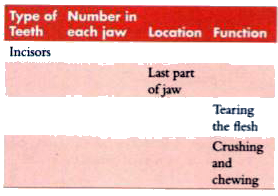Complete Solutions to MASTER THE CONCEPTS (KNOWLEDGE AND UNDERSTANDING) of chapter LIFE PROCESSES IN HUMAN BEING-I (DIGESTIVE AND EXCRETORY SYSTEMS) of Class 10 book with complete answers and questions
| Class 10 | BIOLOGY |
| Chapter | LIFE PROCESSES IN HUMAN BEING-I (DIGESTIVE AND EXCRETORY SYSTEMS) |
| PEARSON IIT JEE FOUNDATION | MASTER THE CONCEPTS (KNOWLEDGE AND UNDERSTANDING) |
| Number Of Questions | 41 |
| Academic Year | 2023-24 |
Mention the different organs that are part of alimentary canal.
01:14View SolutionName the different glands that are associated with the digestive system.
01:26View SolutionComplete the following table.
 View Solution
View SolutionWhat do you mean by dental formula? Explain the dental formula in humans.
01:08View SolutionHow many enzymes are present in pancreatic juice? Name and mention their role in digestion.
01:05View SolutionWhat do you mean by emulsification? Mention its significance.
01:11View SolutionExplain the process of digestion in small intestine.
01:17View SolutionIdentify and explain the structure and function of the gland which secretes the enzyme amylase.
01:12View SolutionExplain the anatomy and function of tongue.
01:11View SolutionWhat is epiglottis? What is its role in the digestive system?
01:13View SolutionExplain the functions of liver in the Regulation of blood sugar.
01:19View SolutionExplain the functions of liver in the Deamination.
01:11View SolutionComplete the table:
 View Solution
View SolutionExplain the assimilation of fats during the process of digestion.
01:03View SolutionDefine the Excretion.
01:04View SolutionDefine the Osmoregulation .
01:02View SolutionName the different organs associated with excretory system.
01:10View SolutionOn the basis of the diagram given, answer the following questions.

Identify A, B, C and D.View SolutionOn the basis of the diagram given, answer the following questions.

What is the structural and function unit of the organ given in the diagram.View SolutionOn the basis of the diagram given, answer the following questions.

Name the parts of the above structural and functional unit.View SolutionName and explain the process that takes place in the network of blood capillaries present outside the Bowman's capsule during the formation of urine.
View SolutionName and explain the process that occurs in distal convoluted tube during the formation of urine.
01:39View SolutionExplain the process of selective reabsorption.
01:15View SolutionLactose intolerance is a common health problem in elderly people. Give reason.
01:16View SolutionHow are cavities in teeth formed?
01:11View SolutionDifferent areas of tongue are responsible for different tastes. Explain.
01:15View SolutionAlthough appendix is considered a vestigial organ in human being, it plays certain role. Explain
01:23View SolutionHow do bile salts emulsify fats?
01:14View SolutionExplain the role of liver in maintaining glucose level in blood throughout the day.
01:18View SolutionWhy do enzymes act in a particular range of temperature?
01:41View SolutionEnzymes are substrate (the molecule on which an enzyme acts) specific. Give the reason.
01:30View SolutionHCl is secreted in stomach to promote the activity of enzymes. Why does this HCl does not corrode the lining of the stomach?
01:18View SolutionWhen we chew a piece of bread for some time, we feel sweet taste in our mouth. Give reason.
01:03View SolutionThe diameter of efferent arteriole is less than that of afferent arteriole. Give reason.
01:27View SolutionWhy is the process taking place in proximal convoluted tubule called reabsorption? What is the significance of this process?
01:40View SolutionHow does the formation of stones take place in kidney?
01:27View SolutionLiver is the main detoxifying organ in the body. Justify.
01:13View SolutionWhy are patients suffering from kidney dis eases advised to take low sodium salts?
01:30View SolutionA disease, gout indicates the malfunction of kidney. Give reason.
01:23View SolutionHyperglycemia increases the frequency of urination. Explain.
01:36View SolutionThe concentration of creatinine in the blood is measured to examine the condition of kidney. Give reason.
01:34View Solution
MASTER THE CONCEPTS (KNOWLEDGE AND UNDERSTANDING) questions and complete solutions for chapter LIFE PROCESSES IN HUMAN BEING-I (DIGESTIVE AND EXCRETORY SYSTEMS) of PEARSON IIT JEE FOUNDATION of Class 10
All Exercises from PEARSON IIT JEE FOUNDATION Class 10 BIOLOGY LIFE PROCESSES IN HUMAN BEING-I (DIGESTIVE AND EXCRETORY SYSTEMS)
- ASSESSMENT TESTS (ANSWER THE QUESTIONS)
- ASSESSMENT TESTS (FILL IN THE BLANKS)
- ASSESSMENT TESTS (SELECT THE CORRECT ALTERNATIVES)
- ASSESSMENT TESTS (TRUE OR FALSE)
- ASSESSMENT TESTS (WRITE THE MISSING CORRELATED TERMS)
- MASTER THE CONCEPTS (ASSERTION AND REASON)
- MASTER THE CONCEPTS (KNOWLEDGE AND UNDERSTANDING)
- QUIK RECAP
- TEST YOUT CONCEPTS (FILL IN THE BLANKS)
- TEST YOUT CONCEPTS (SELECT THE CORRECT ALTERNATIVES)
